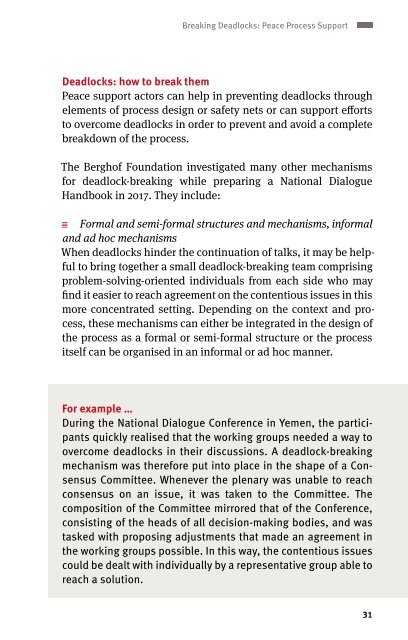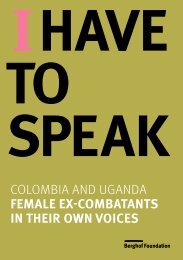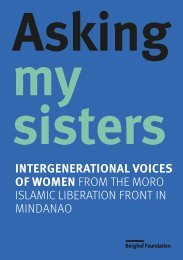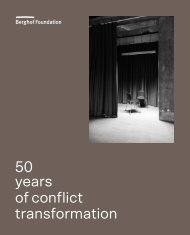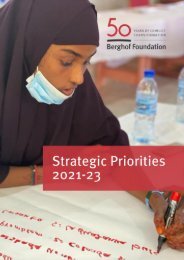Berghof Glossary on Conflict Transformation
The Berghof Glossary on Conflict Transformation presents 20 of the main principles and approaches used by the Berghof Foundation in its work. It is a concise and accessible exploration of what it takes to create “space for conflict transformation”. 2019 edition.
The Berghof Glossary on Conflict Transformation presents 20 of the main principles and approaches used by the Berghof Foundation in its work. It is a concise and accessible exploration of what it takes to create “space for conflict transformation”. 2019 edition.
Create successful ePaper yourself
Turn your PDF publications into a flip-book with our unique Google optimized e-Paper software.
Breaking Deadlocks: Peace Process Support<br />
Deadlocks: how to break them<br />
Peace support actors can help in preventing deadlocks through<br />
elements of process design or safety nets or can support efforts<br />
to overcome deadlocks in order to prevent and avoid a complete<br />
breakdown of the process.<br />
The <str<strong>on</strong>g>Berghof</str<strong>on</strong>g> Foundati<strong>on</strong> investigated many other mechanisms<br />
for deadlock-breaking while preparing a Nati<strong>on</strong>al Dialogue<br />
Handbook in 2017. They include:<br />
Formal and semi-formal structures and mechanisms, informal<br />
and ad hoc mechanisms<br />
When deadlocks hinder the c<strong>on</strong>tinuati<strong>on</strong> of talks, it may be helpful<br />
to bring together a small deadlock-breaking team comprising<br />
problem-solving-oriented individuals from each side who may<br />
find it easier to reach agreement <strong>on</strong> the c<strong>on</strong>tentious issues in this<br />
more c<strong>on</strong>centrated setting. Depending <strong>on</strong> the c<strong>on</strong>text and process,<br />
these mechanisms can either be integrated in the design of<br />
the process as a formal or semi-formal structure or the process<br />
itself can be organised in an informal or ad hoc manner.<br />
For example …<br />
During the Nati<strong>on</strong>al Dialogue C<strong>on</strong>ference in Yemen, the participants<br />
quickly realised that the working groups needed a way to<br />
overcome deadlocks in their discussi<strong>on</strong>s. A deadlock-breaking<br />
mechanism was therefore put into place in the shape of a C<strong>on</strong>sensus<br />
Committee. Whenever the plenary was unable to reach<br />
c<strong>on</strong>sensus <strong>on</strong> an issue, it was taken to the Committee. The<br />
compositi<strong>on</strong> of the Committee mirrored that of the C<strong>on</strong>ference,<br />
c<strong>on</strong>sisting of the heads of all decisi<strong>on</strong>-making bodies, and was<br />
tasked with proposing adjustments that made an agreement in<br />
the working groups possible. In this way, the c<strong>on</strong>tentious issues<br />
could be dealt with individually by a representative group able to<br />
reach a soluti<strong>on</strong>.<br />
31


